Bruno Barnhart brought me right into life in the world when he opened the second chapter of The Future of Wisdom with the words, “Wisdom begins in wonder. Something profound awakens when a child opens a book and finds its pages full of light, the words radiant even though their meanings remain indistinct.” He ends this first paragraph of the second chapter, entitled, “Movement I: The S apiential Awakening,” saying: “spiritual wisdom… is always a beginning… a simple, luminous fullness” and that, in the “cold clarity of the modern West, it is often the poets who catalyze the awakening of a sapiential consciousness.”
apiential Awakening,” saying: “spiritual wisdom… is always a beginning… a simple, luminous fullness” and that, in the “cold clarity of the modern West, it is often the poets who catalyze the awakening of a sapiential consciousness.”
Bruno leads us on a spiral journey through the Christian sapiential tradition, beginning with three quick, broad strokes. The first—the Awakening! above—speaks to the reader directly and personally, and comes out of his own spiritual awakening as a young person. It sets the tone, alerting the reader that this is about a living Wisdom, not a concept, or shell of an idea. The second stroke takes us from poets and children, enchantment, eager spirits and new discoveries to the event of Christ as “the coming of the divine Wisdom to humanity as a human person.” This, is real. It is about us.
Bruno places Christ as the incarnation of divine Wisdom at the center; as the mystery that was alive for the early Christians, a sapiential reality. He quotes 1 John 1:1-2, “That which… we have heard… we have seen… we have looked upon and touched with our hands, concerning the word of life—the life was made manifest and we saw it…” The centrality of the Christ-event was followed by the eclipse of that mystery and Bruno speaks of how quickly that intimacy was forgotten; in his words: reduced, objectified, rationalized and codified, institutionalized, even militarized. What was then unified was divided, and we moved from participation in the mystery to an idea of a wisdom that contains the mystery.
The last stroke Bruno sounds at the beginning of his chapter is a renewal in modern times, a third force, awakening between “a reductionist rationalism” (a “scientism”) and “an immobile institutionalized dogmatism” (contrasted by a “fundamentalism”). As imagery and sacrament, mystery and unity arise from the depths of consciousness, a yielding is occurring—in Bruno’s words, to “allow the mystery to express itself.” Courageously, Vatican II “confident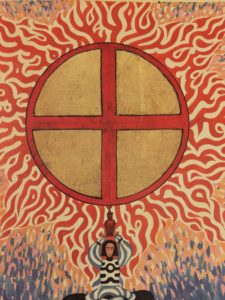 ly embraced the mystery of Christ,” refreshing language, freeing meaning, and remembering “its native language as that of Christian wisdom.” This was marked change in the history of the church, a response to a movement already underway, and it cleared the path for a new sapiential awakening.
ly embraced the mystery of Christ,” refreshing language, freeing meaning, and remembering “its native language as that of Christian wisdom.” This was marked change in the history of the church, a response to a movement already underway, and it cleared the path for a new sapiential awakening.
I am enjoying following the threads that Bruno is weaving through the development of the church, through history, through particular persons, human evolution and personal spiritual life. The golden thread, undulating through this chapter is the Christ-event. The colors that are brought into the light through that mystery weave through the chapter as qualities of an enlivened Wisdom. As Bruno takes us through another trifold round on the spiral, he calls on the work of three monastic scholars: Henri de Lubac, Jean Leclercq and Cipriano Vagaggini. Their studies provide scaffolding for our comprehension of the course of Christian Wisdom over time. We hear Wisdom bursting through the old order through the spiritual understanding of text, the promise of a new unfolding, an emerging symbolic consciousness, clarity and union, a higher knowledge completed in prayer and contemplation, sacred personal experience… and disappear again in the descriptions of the losses, the forgettings, the separations, and the building of rigid dogmas, ascending and descending ladders, institutions and structures.
Underneath, Bruno is working the paradoxes. I feel his commitment to mend, to embrace, to span the distance between what appears as irreconcilable. I was struck by this passage in his discussion of Leclercq, as I found myself standing on both sides of the divide:
Today we may be able to imagine ourselves on either side of the divide—with Bernard or with Ablelard—feeling on the one hand a deep identification with that unitive interiorizing of the mystery that proceeds through an absorption in the Word, and on the other hand experiencing within ourselves the thrill of personal discovery, of a new rational autonomy, of the divine spark of freedom and creativity which is eager to participate actively in the birth of a new world.
Bruno concludes this second turn of the spiral with a call for the “recovery of unity: the original unity of the mystery of Christ,” in this sapiential awakening. He speaks of a “movement of returns”: “return… to the undivided church… to the intimate union of mysticism—and spirituality—with the mystery… we return—but with a modern personalist perspective—to a unitive vision that had prevailed before the separation…”
Bruno then draws us down to another level, and a third turn of the spiral into the heart of the mystery, and our loss of it. Beginning with the “Quaternary Unfolding of the Christ Mystery,” through what Bruno calls “The Revolution of Jesus,” he leaves us with “Rationalization of the Mystery.” It opens with 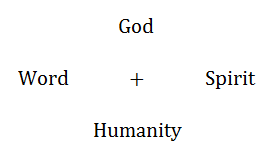 the sobering line from T.S. Eliot, “Humankind cannot bear very much reality.” This impactful round on the ring prepares us for the deep dive into two contemporary towers of Wisdom, Thomas Merton and Karl Rahner.
the sobering line from T.S. Eliot, “Humankind cannot bear very much reality.” This impactful round on the ring prepares us for the deep dive into two contemporary towers of Wisdom, Thomas Merton and Karl Rahner.
It is a bit like being in the labyrinth with our author; the short and long segments of the road each lending their own experience to the whole journey as we are drawn in, closer and closer to the center. There is a sacred geometry that Bruno sees written throughout Christian sapiential understanding, a quaternity re-emerging over and again. The cross locates Christ at the center of everything, here and now, Bruno says, “as the fusion of God and creation, of Trinity and humanity.” It is written in creation.
With a blunt and concise two sentences he then tears right through the heart:
The Christian history of the past two thousand years has been characterized by a continual tendency to reverse the event of incarnation and separate once again the divine and the human, Trinity and humanity, God and creation. This separation is then made permanent in theological and institutional structures.
The evolutionary note sings as Bruno continues, distinguishing Christian sapiential wisdom as the reality that puts 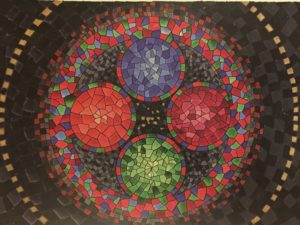 this unity front and center again, in the present tense, as well as defining the flowering and fulfillment of creation with God in a “eucharistic plentitude.”
this unity front and center again, in the present tense, as well as defining the flowering and fulfillment of creation with God in a “eucharistic plentitude.”
“The Revolution of Jesus” is what Bruno calls “a response to the question: … What is really new in the Christ-event that was not already present beforehand…? It is a series of seven steps or phases which move from the very intimate—in the form of a personal awakening—to creative evolutionary patterns of the cosmos expressed both in a new individual freedom that acts as source, and in the full embodiment of creation as the body of Christ.
In the middle of this unfolding “revolution” are Bruno’s phases IV and V—reversals and embodiment. Following the divinization of phase III, I feel a great beauty in the movements of Bruno’s vision, as he calls with clear voice for the reversal of the ascent. Lovingly, he invites the descent, naming it as “embodiment… the descending path of incarnation in the life of an individual… the life of a community or society.” He speaks about other energetic reversals: one being the movement during a lifetime to living from ‘within,’ rather than from ‘without.’ It has been fascinating for me to notice this in life more and more; what it is to sense an autonomous inner core, and respond and act from kenotic inner knowing rather than from outer expectation, rule or law. Coupled with this, and operating on the level of culture as well as within an individual person, is the new freedom and creativity in the participatory dance with God and creation.
Bruno uses the brilliant phrase “the scandal of particularity” to illuminate what I understand as the mysterious paradox of the Divine as part and parcel of earthly matter in its specificity of form and substance—which opens like a treasure box into the boundless potentiality of life in the divine exchange. We are all, in our particularity, necessary. Quickened between divine spark and earthly substance, Bruno names the purpose of this “revolution of Jesus”: to “initiate a new sacramental creation.”
In “Rationalization of the Mystery,” and as prelude to his discussion of Merton and Rahner, Bruno’s commitment to the living presence of the reality of the mystery becomes all the more tender. The loss of the felt sense of the Christ event is heartbreaking as Bruno presents it more specifically: the fall of the mystery into a ‘religion,’ domesticated and controlled, split, mutilated, and abandoned as the church becomes elevated; mysticism sequestered in an “interior tabernacle of pure spirit;” Eucharist no longer a lived reality, reduced to ritual; and God locked away in a distant heaven while the “three persons” are taken out of the exchange in life and made “immanent Trinity.” The church is now experienced as outer authority, rather than our common living body.
The personal element at the heart of the mystery of the Christ-event draws us nearer, as Bruno takes us deeper into the labyrinth of Christian Wisdom. It is more poignant, given the life Bruno has breathed into the centrality of the unitive force a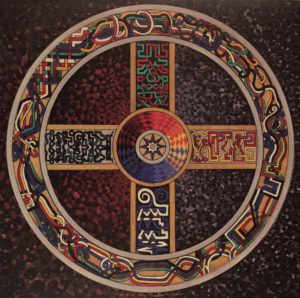 nd mystery of Christ, that Bruno then devotes half the chapter to the particular and wildly different ways that Merton and Rahner open up the mystery for us in our time. The tribute to the contributions of both these human beings is beautifully wrought. It is the life of Merton that unfolds over these few pages, as Bruno traces the dance of Merton’s personal encounter with the Divine and the way he brought it to the world, questioning, reconnecting, expressing his inner being. Bruno quotes Armand Viellieux as saying, Merton “will remain known in history not so much by the things he wrote as by what he was.” It is his fullness of being that Bruno captures so fully with so few words. Merton remains, for me, and accentuated through Bruno, an icon of sapiential awakening within an individual human being that then radiates out, in that most particular way that is reflective of his ray, into the world and continuing after his death.
nd mystery of Christ, that Bruno then devotes half the chapter to the particular and wildly different ways that Merton and Rahner open up the mystery for us in our time. The tribute to the contributions of both these human beings is beautifully wrought. It is the life of Merton that unfolds over these few pages, as Bruno traces the dance of Merton’s personal encounter with the Divine and the way he brought it to the world, questioning, reconnecting, expressing his inner being. Bruno quotes Armand Viellieux as saying, Merton “will remain known in history not so much by the things he wrote as by what he was.” It is his fullness of being that Bruno captures so fully with so few words. Merton remains, for me, and accentuated through Bruno, an icon of sapiential awakening within an individual human being that then radiates out, in that most particular way that is reflective of his ray, into the world and continuing after his death.
Karl Rahner, too, Bruno paints with a skillful hand. He guides us into Rahner’s work through the fourfoldness of his own vision, the central thread based on the cross that is “inscribed in the cosmos.” He speaks of Rahner’s feeling for God as “holy mystery,” and the way he opens the Trinity and incarnation, inviting us to its participatory nature. Bruno says that Rahner’s gift is that through his work, “While the essential distinctions remain, the boundaries have become permeable, and theology has become once again an interaction of totalities: God, person, humanity, the created universe.” Bruno’s appreciation of that which links and reconnects beyond the binary strikes a chord again––in his embrace of both the distinctions and the permeable boundaries.
This time, what strikes me about Rahner (because The Future of Wisdom is a living text, it will almost necessarily be a different aspect or moment that will catch my breath on the next read), is his use of the word ‘transcendence.’ I realize I have reduced that word to an idea of a dissolving person in a boundless God, and lost the word itself and my relationship to it in the process. In my judgment, the word became empty to me, disembodied, a name for a fabricated “goal,” and unconsciously believing the culture co-opted it, I did not own my part in the loss. It opens and delights me to see that Rahner sees transcendence as including the ground of being, all of our being, and says, “a person, then, means the self-possession of a subject as such in a conscious and free relationship to the totality of itself.” Bruno himself goes on to say, “This human participation in God which Rahner calls transcendence is the source of every truly personal or spiritual act… it locates human life—as well as human consciousness and thought—on a plane of divine immediacy which is implicitly sapiential.” It is an inclusive rather than a separating transcendence, one that does not leave the person behind or God outside.
At the end of Chapter II, we are at the center of the labyrinth of the Christian Wisdom tradition, as it has emerged 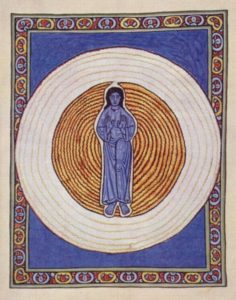 and been eclipsed and re-emerged throughout its human journey in time. Bruno stands in his conclusion to this first of four Movements, The Sapiential Awakening, with these words: “Wisdom is loving faith, and Christian faith is the dark knowing of embodied light, of incarnation… This is not a specialization, nor does it bring into being a contemplative or sapiential elite. As we shall see, the shape of Christian life corresponds to the pattern of Jesus’ own life on this earth.”
and been eclipsed and re-emerged throughout its human journey in time. Bruno stands in his conclusion to this first of four Movements, The Sapiential Awakening, with these words: “Wisdom is loving faith, and Christian faith is the dark knowing of embodied light, of incarnation… This is not a specialization, nor does it bring into being a contemplative or sapiential elite. As we shall see, the shape of Christian life corresponds to the pattern of Jesus’ own life on this earth.”
This life on earth that is Jesus’s is participatory, and includes in a sapiential way, my own very specific “scandal of particularity,” and yours. Bruno’s gift in this chapter is the heartfelt excavation and recovery of the Christian tradition in all its glory. “Every cell of this body sings glory!” sounds the chant, as Bruno tenderly places the mystery and the cross in its immediacy and aliveness at the center of the Christian tradition, at the center of all life, our daily life and with all things; and in the center of our very bodies, our hearts.

Laura,
This morning I was going to prepare for tomorrow’s “Future of Wisdom Zoom” by reviewing my notes but remembered seeing an email that said you wrote about the second chapter so began here instead. Your ability to capture Bruno’s thought and share it with such beauty, grace and your own deep appreciation has touched me deeply. I’m in awe by what you captured and how you captured it. It reveals to me that I need to ask the Holy Trinity to lead me into a new way of thinking and being as I continue reading this marvelous book. Thank you for sharing your reflections.